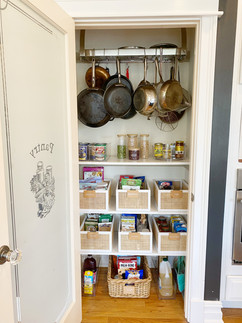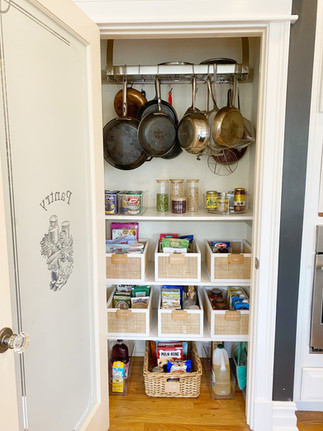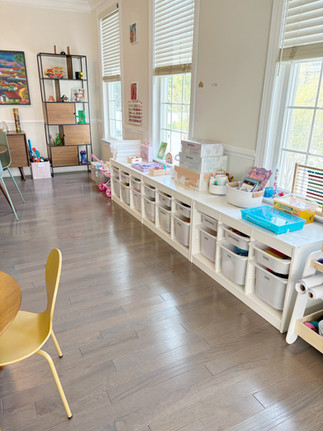- Jackie
In a world where consumerism is constantly at our fingertips, it’s easy to get caught up in the cycle of acquiring more—whether it’s the latest gadget, trendy decor, or just things we think we might need one day. But the truth is, the more stuff we have, the more it weighs us down, both mentally and physically. As professional organizers, we've seen firsthand how a minimalistic lifestyle can transform not just a home, but an entire life. If you’re feeling overwhelmed by clutter and chaos, our simple-living tips could be the solution you didn’t know you were looking for.
What is a minimalist lifestyle?
It's all about simplifying your life by owning fewer things that add real value or joy. It’s not just about getting rid of stuff, but being intentional with what you allow into your life and your home. Living simply allows you to make space—both physically and mentally—for what truly matters.
The Power of Changing Your Purchasing Habits
One of the biggest contributors to household clutter is our buying habits. We’re often tempted by sales, or “must-have” items. Over time, these impulse buys add up, leading to drawers full of unused items and shelves overcrowded with things we don’t truly need. But when we shift our mindset, we can begin to change our approach to consumption.

Step 1 - Be Mindful of What You Bring Into Your Home
Before making a purchase, ask yourself, “Do I really need this? Will it add value to my life, or will it just take up space?” If the answer is unclear, consider waiting 24 hours before buying. This pause can help you resist the urge for instant gratification and encourage more thoughtful decision-making.
Step 2 - Quality Over Quantity
Instead of buying many cheap or trendy items, invest in fewer, higher-quality pieces that will last longer and serve a real purpose. Whether it’s clothing, furniture, or kitchen gadgets, focusing on quality can save you money in the long run and reduce waste.
Step 3 - Embrace the "One In, One Out" Rule
This simple rule can help keep your home clutter-free: for every new item you purchase, get rid of one you no longer need or use. It prevents your things from multiplying and encourages you to stay intentional with your purchases.
The Importance of Decluttering
Even with careful purchasing habits, stuff can still pile up over time. This is where regular purging comes in. It’s not just about spring cleaning once a year—it’s about making decluttering a habit that keeps your home and your life in balance.
1. The Emotional Freedom of Letting Go
Many people hold onto items because of sentimental value or the belief that they might “need” them someday. But clutter can cause stress and anxiety. Regular purging helps you clear out the things that no longer serve a purpose, making space for the things you truly love and use.
2. Create a Maintenance Routine
Consider setting a time each month or season to go through your things. Tackle one category at a time (like clothes, books, kitchen gadgets) and assess whether each item still adds value. Purging regularly helps prevent your home from becoming overwhelmed with unnecessary things and keeps your environment organized.
3. Don’t Wait for the Perfect Moment
A common misconception is that you need to declutter when you have the time or when you’re in the right mood. The reality is, decluttering doesn't need to be an all-day event. Start small by decluttering for 15-30 minutes each week. A few minutes here and there will add up over time, and you’ll be amazed at how much lighter and more organized your space will feel.
The Ripple Effect
When you start to embrace a minimalist mindset through intentional purchasing and regular decluttering, you’ll notice some incredible benefits that go far beyond a tidy home.
Less Stress, More Peace
Cluttered spaces can lead to a cluttered mind. By minimizing physical distractions, you free up mental space, which helps reduce stress and anxiety. You'll find it easier to relax and focus on what truly matters.
More Time and Energy
The less time you spend maintaining things, the more time you have to focus on what’s important to you—whether it’s pursuing hobbies, spending time with loved ones, or just taking a break.
Financial Freedom
Changing your purchasing habits means you’re less likely to waste money on things you don’t truly need. Instead of making impulse purchases, you’ll prioritize saving and investing in what really adds value to your life. This can lead to a more sustainable financial future.
A Sense of Accomplishment
Every time you declutter or make a conscious, thoughtful purchase, you’re actually shaping a lifestyle that aligns with your values. This process of intentional living can create a deep sense of fulfillment and accomplishment.

If you're feeling overwhelmed by the clutter in your life, take the first step today. Start small, be mindful of what you bring into your home, and make purging a regular habit. The more intentional you become about what you keep, the more peaceful, organized, and fulfilling your life will become.











































